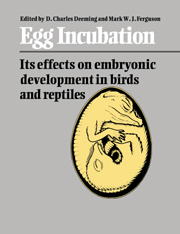Book contents
- Frontmatter
- Contents
- Preface
- Contributors
- 1 Maternal diet, maternal proteins and egg quality
- 2 Comparative composition and utilisation of yolk lipid by embryonic birds and reptiles
- 3 Oviductal proteins and their influence on embryonic development in birds and reptiles
- 4 Fluxes during embryogenesis
- 5 Eggshell structure and formation in eggs of oviparous reptiles
- 6 Shell structure and formation in avian eggs
- 7 Physical characteristics of reptilian eggs and a comparison with avian eggs
- 8 Egg-shape in birds
- 9 The thermal energetics of incubated bird eggs
- 10 Physiological effects of incubation temperature on embryonic development in reptiles and birds
- 11 Cold torpor, diapause, delayed hatching and aestivation in reptiles and birds
- 12 Physical factors affecting the water exchange of buried reptile eggs
- 13 Physiological and ecological importance of water to embryos of oviparous reptiles
- 14 Roles of water in avian eggs
- 15 Water economy and solute regulation of reptilian and avian embryos
- 16 The avian eggshell as a mediating barrier: respiratory gas fluxes and pressures during development
- 17 Gas exchange across reptilian eggshells
- 18 Metabolism and energetics of reptilian and avian embryos
- 19 Reasons for the dichotomy in egg turning in birds and reptiles
- 20 A comparison of reptilian eggs with those of megapode birds
- 21 Why birds lay eggs
- 22 Influences of incubation requirements on the evolution of viviparity
- 23 Overview of early stages of avian and reptilian development
- 24 Ions and ion regulating mechanisms in the developing fowl embryo
- 25 Electrochemical processes during embryonic development
- 26 Methods for shell-less and semi-shell-less culture of avian and reptilian embryos
- 27 Experimental studies on cultured, shell-less fowl embryos: calcium transport, skeletal development, and cardio-vascular functions
- Index
26 - Methods for shell-less and semi-shell-less culture of avian and reptilian embryos
Published online by Cambridge University Press: 16 November 2009
- Frontmatter
- Contents
- Preface
- Contributors
- 1 Maternal diet, maternal proteins and egg quality
- 2 Comparative composition and utilisation of yolk lipid by embryonic birds and reptiles
- 3 Oviductal proteins and their influence on embryonic development in birds and reptiles
- 4 Fluxes during embryogenesis
- 5 Eggshell structure and formation in eggs of oviparous reptiles
- 6 Shell structure and formation in avian eggs
- 7 Physical characteristics of reptilian eggs and a comparison with avian eggs
- 8 Egg-shape in birds
- 9 The thermal energetics of incubated bird eggs
- 10 Physiological effects of incubation temperature on embryonic development in reptiles and birds
- 11 Cold torpor, diapause, delayed hatching and aestivation in reptiles and birds
- 12 Physical factors affecting the water exchange of buried reptile eggs
- 13 Physiological and ecological importance of water to embryos of oviparous reptiles
- 14 Roles of water in avian eggs
- 15 Water economy and solute regulation of reptilian and avian embryos
- 16 The avian eggshell as a mediating barrier: respiratory gas fluxes and pressures during development
- 17 Gas exchange across reptilian eggshells
- 18 Metabolism and energetics of reptilian and avian embryos
- 19 Reasons for the dichotomy in egg turning in birds and reptiles
- 20 A comparison of reptilian eggs with those of megapode birds
- 21 Why birds lay eggs
- 22 Influences of incubation requirements on the evolution of viviparity
- 23 Overview of early stages of avian and reptilian development
- 24 Ions and ion regulating mechanisms in the developing fowl embryo
- 25 Electrochemical processes during embryonic development
- 26 Methods for shell-less and semi-shell-less culture of avian and reptilian embryos
- 27 Experimental studies on cultured, shell-less fowl embryos: calcium transport, skeletal development, and cardio-vascular functions
- Index
Summary
Introduction
Shell-less culture of embryos is a technique which involves culturing embryos with associated yolk and albumen outside of the eggshell and shell membranes. In contrast to shell windowing techniques, shell-less culture allows continuous observation of, and access to developing embryos and extra-embryonic membranes almost to the time of hatching. Injections can be made into, or operations performed on, a specific portion of the embryo, and resultant changes in heart rate, behaviour, regional growth or other parameters observed continuously without having to sacrifice the embryo. Due to lack of adhesion of extra-embryonic membranes to an overlying shell window, multiple injections or operations can be performed on a given embryo in shell-less culture. Additionally, grafts consisting of embryonic, neoplastic or other tissue onto the chorio-allantoic membrane of a single embryo can be followed routinely without having to sacrifice either host or graft tissue. Of particular interest, avian embryos maintained in shell-less culture become calcium-deficient due to the absence of the eggshell (Dunn & Boone, 1977; Tuan, 1980, 1983; Richards, 1982; Ono & Wakasugi, 1984). Thus, shell-less culture provides a unique experimental system for studying the relationships between calcium homeostasis and other metabolic and physiological functions during development (Tuan et al., Chapter 27). In the past, investigators have cultured avian embryos in a variety of vessels including: glass dishes (Assheton, 1896; Fere, 1900; Loisel, 1900; Paton, 1911; Vogelaar & van den Boogert, 1925; Vollmar, 1935; Schmidt, 1937), ceramic dishes (Corner & Richter, 1973), beakers (Romanoff, 1943; Boone, 1963; Palen & Thorneby, 1976) evaporating dishes (DeGennaro et al, 1980), plastic shells (Quisenberry & Dillon, 1962), petri dishes (Williams & Boone, 1961), sandwich bags (Schlesinger, 1966; Elliot & Bennet, 1971), and in sandwich-type plastic wrap in several configurations (Criley, 1971; Dunn, 1974) with varying degrees of success.
- Type
- Chapter
- Information
- Egg IncubationIts Effects on Embryonic Development in Birds and Reptiles, pp. 409 - 418Publisher: Cambridge University PressPrint publication year: 1991
- 2
- Cited by



